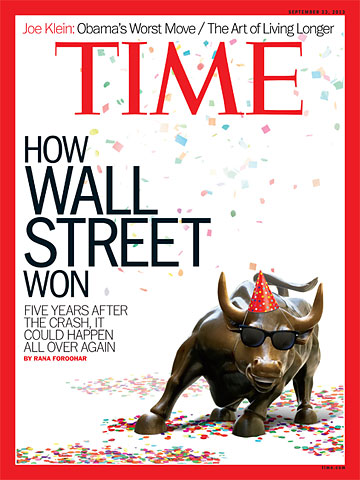
(2 of 6)
A simpler bank is a safer bank. Yet the banking lobby has spent hundreds of millions of dollars beating back regulatory efforts to scale down the size and complexity of banking operations. Thanks in part to heavy lobbying by the financial industry, only 40% of the new rules called for by Dodd-Frank have been written. No wonder banks have bucked the regulation; it might require them to focus more on lower-profit lending to businesses that create jobs rather than risky but potentially far more profitable proprietary trading. "The too-big-to-fail problem hasn't ended," says economist and MIT professor Simon Johnson. "Banks are just as complex and global and even bigger than they were before the crisis."
It's a statement that even many bankers, including former Merrill Lynch CEO John Thain and former Citigroup head Sandy Weill, agree with. Dodd-Frank creates something of a road map for winding down failing U.S. banks, but a lack of international standards (a void that also reflects bank lobbying) means there's still no easy way to wind down global financial institutions.
Worse, some may now be too big to manage, meaning internal and regulatory safeguards are overwhelmed by the complexity of trading operations. Experts including The Black Swan author Nassim Nicholas Taleb and Stanford finance professor Anat Admati have written that banks can twist data to make predictions ungrounded in the real world yet sufficient to pass government-mandated stress tests.
One solution: the Volcker rule, proposed by former Fed chairman Paul Volcker, which would separate government-insured commercial lending from risky trading operations. "We need firewalls between risky trading and federally backed commercial lending, period," says former FDIC chairwoman Sheila Bair. "Banks need the markets to fund risky trading--not individuals' deposits." It's an obvious move to limit taxpayer liability, but so far, the rule remains unwritten and may not be implemented for years.
No. 2
Limit the Leverage
Banks can't function without leverage, or the ability to borrow more money than they can immediately repay. So when sizing up a bank, one critical measure is its leverage ratio, which reflects the amount of high-quality, loss-absorbing, bank-owned capital available to repay those loans when needed. Too little leverage can constrict operations; too much means a high risk that the bank won't be able to meet its obligations if they are called in.
